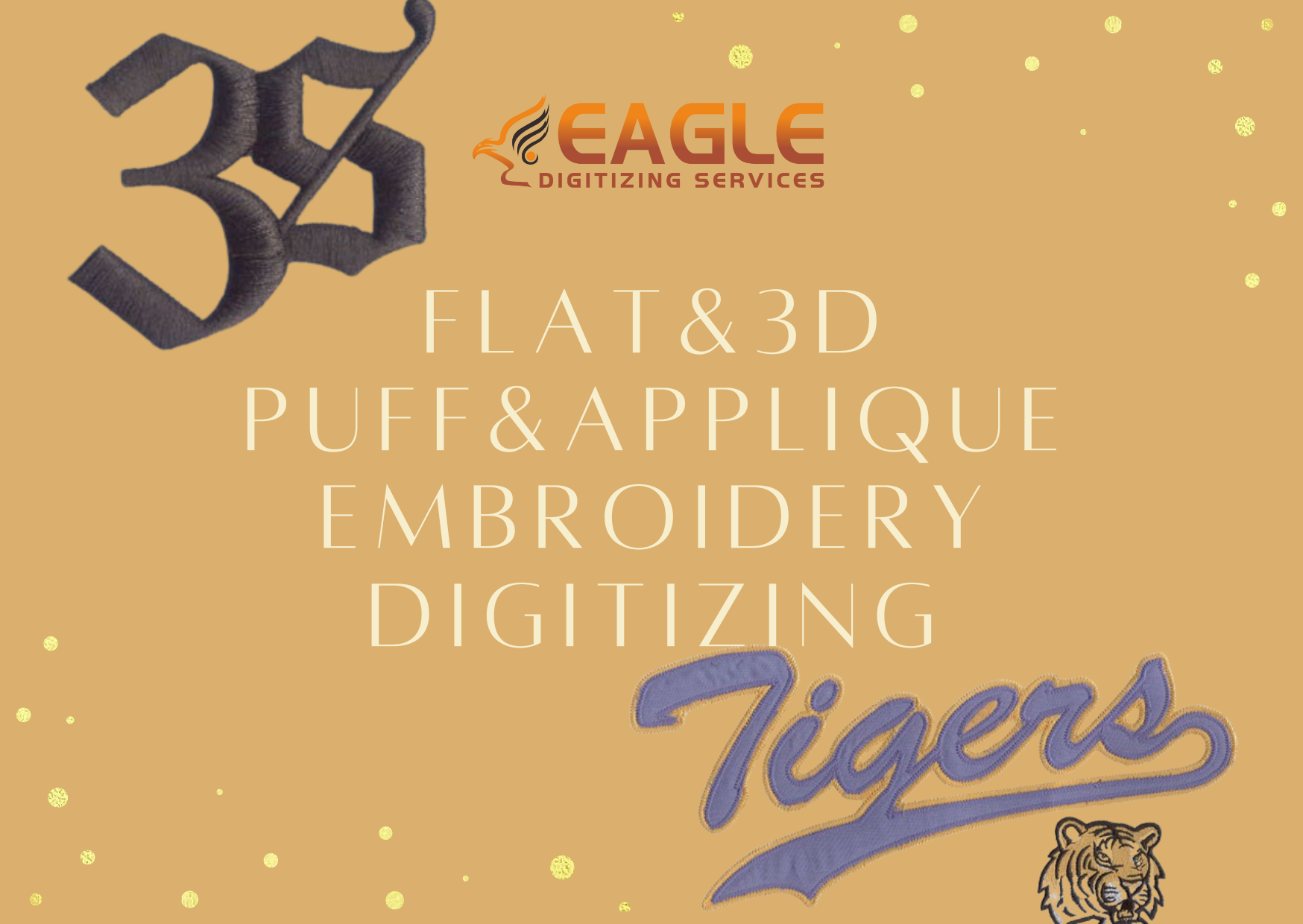How to enhance innovative designs of custom t-shirts using the latest embroidery digitizing technology
Embroidery digitizing has transformed the world of custom t-shirt design, offering creators an unparalleled ability to bring their ideas to life with precision and creativity. This powerful tool acts as the bridge between abstract concepts and tangible designs, enabling a seamless transition from imagination to physical artwork. For professionals and newcomers alike, understanding embroidery digitizing is crucial to mastering the craft and achieving stunning custom apparel. As we dive into the role of technology in this process, we’ll uncover how it elevates the world of t-shirt design, making it easier than ever to transform any vision into a work of art.
Why
Digitizing is Key to Transforming Ideas into Threaded Art
Creating a custom t-shirt is more than just printing a design onto
fabric; it’s an art form where your creative ideas must be translated into
something both wearable and beautiful. Embroidery digitizing is the magic
behind turning your vision into reality. It transforms digital artwork into a
sequence of commands that embroidery machines can follow, ensuring every stitch
is perfectly placed. This process involves both technical knowledge and artistic
flair, resulting in designs that are not only visually striking but also
durable and high-quality. It’s an essential part of the creative journey,
enabling designs to stand out through their intricacy, texture, and vibrancy.
Understanding
the Basics: What is Embroidery Digitizing?
Embroidery digitizing is the process of converting a digital image or
artwork into a language that embroidery machines can read and execute. This
complex process requires careful planning of each stitch type, such as satin,
fill, or running stitches, as well as selecting the appropriate thread colors.
Without digitizing, achieving the intricate detail needed for high-quality
embroidery would be virtually impossible. It’s what transforms a simple graphic
into an intricate, textured piece of art. Whether for personal or commercial
use, digitizing ensures that your designs are both visually appealing and
feasible for embroidery machines to replicate with precision.
How Technology Revolutionizes the Traditional Embroidery Process
Before digitizing, embroidery was a painstakingly manual process,
relying on skilled hands to stitch intricate designs one thread at a time.
Today, technology has revolutionized this practice, making it faster, more
efficient, and more versatile. With the help of advanced embroidery machines,
digitized designs can be executed with incredible precision, significantly
reducing the time it takes to complete a design. This not only allows for more
detailed and intricate designs but also opens the door for greater creativity.
Designers can now experiment with complex patterns, textures, and effects that
would have been nearly impossible to achieve by hand, revolutionizing the way
custom t-shirts are made.
Choosing
the Right Design Software for Seamless Embroidery Digitizing
Selecting the right software is crucial for any designer working with
embroidery. The right tool will help you create seamless, professional-quality
designs with ease, while the wrong one can lead to frustration and subpar
results. Good embroidery digitizing softwareshould offer user-friendly interfaces, a wide range of stitch options, and
compatibility with various file formats. Features like real-time previews,
automatic adjustments, and advanced editing tools can help reduce errors and speed
up the design process. Whether you’re designing simple logos or intricate
patterns, the right software ensures that your design translates flawlessly
from screen to fabric.
Exploring
the Top Embroidery Software That Unlocks Creative Potential
The world of embroidery software is vast, with numerous options to
suit different skill levels and design needs. Programs like CorelDRAW, Wilcom,
and Hatch stand out for their diverse feature sets, including tools for
detailed stitch customization, 3D effects, and layering. These programs allow
designers to work with a wide array of textures, fabrics, and thread types,
unlocking endless creative possibilities. Some software also offers intuitive
interfaces, making it accessible for beginners, while others cater to professionals
seeking advanced features. With the right software, the possibilities for
creating one-of-a-kind t-shirt designs are virtually limitless.
The
Magic of Digitizing: Converting Artwork into Stitched Masterpieces
Turning a concept into a stitched masterpiece is the true magic of
embroidery digitizing. Every design begins with an idea, but to make it a
reality, it must be translated into the language of embroidery. Through
digitizing, designers control the placement, direction, and density of every
stitch, ensuring the design stays true to its original concept while remaining
practical for embroidery. This meticulous process ensures that each stitch
flows seamlessly into the next, resulting in a flawless finished product. The
ability to perfect even the most complex designs is what makes digitizing such
a powerful tool for creating professional custom t-shirts.
Important
Qualities of Embroidery Digitizing Software
When choosing embroidery software, it’s important to consider the
features that will help you achieve your creative vision. Key features to look
for include powerful stitch editing tools, the ability to preview your designs
in real time, and a wide selection of stitch types. A good software program
should also allow you to customize settings based on fabric type and thread
selection, ensuring your designs will work well across different materials.
Compatibility with various embroidery machines and file formats is also
essential for a smooth workflow. The more control the software gives you, the
more freedom you’ll have to experiment and refine your designs.
Balancing
Creativity and Functionality: How to Get the Best of Both Worlds
The embroidery design is a delicate
balance of artistry and technique. While it’s important to let your creativity
flow, it’s equally essential to consider the practicalities of the embroidery
process. A design that looks great on a screen may not always translate
perfectly to fabric, which is where digitizing comes in. The software allows
you to adjust designs for stitch density, fabric texture, and machine
capabilities, ensuring that your artistic vision remains intact while meeting
the technical demands of the process. The ability to balance creativity with
functionality is what separates good designs from great ones.
Enhancing
Detail and Precision in Your T-Shirt Designs with Technology
Technology has dramatically improved the level of detail and precision
achievable in embroidery. With digitizing, designers can refine every aspect of
their design, from the smallest text to the most intricate patterns. This
allows for a level of detail that would be nearly impossible with hand
stitching. The ability to control stitch lengths, densities, and directions
means that even the most fine and delicate designs can be brought to life with
perfect accuracy. This precision elevates custom t-shirt designs from simple
graphics to intricate works of art, making them stand out in a crowded market.
Why
Fine Detail Matters in Custom T-Shirts and How Digitizing Delivers
In the world of custom t-shirts, the smallest details can have the
biggest impact. Fine details, such as tiny text, small graphic elements, or
subtle textures, add depth and sophistication to a design. Digitizing allows
these details to be executed with clarity and accuracy, ensuring that nothing
gets lost in the stitching process. By capturing every nuance of the original
design, digitizing ensures that even the smallest elements contribute to the
overall visual harmony of the piece. This attention to detail is what
transforms a simple t-shirt into a unique, custom creation that stands out from
the crowd.
Adding
Intricate Patterns and Textures to Your Designs for Maximum Impact
One of the greatest advantages of embroidery digitizing is its ability
to incorporate intricate patterns and textures that make a design truly pop. By
adjusting stitch types and densities, designers can add depth and dimension to
their t-shirt designs, giving them a tactile quality that flat print designs
simply can’t replicate. Whether it’s a delicate floral pattern, a geometric
design, or a subtle gradient, digitizing opens up a world of possibilities for
adding texture and visual interest. This not only makes your designs more
captivating but also enhances the overall quality and craftsmanship of the
final product.
Customizing
Thread Colors and Fabrics to Bring Your Design Vision to Life
A design is only as good as the materials used to create it.
Embroidery digitizing allows you to carefully select thread colors and fabrics
that complement your artwork, ensuring that the final product looks as vibrant
and dynamic as you envision it. Whether you choose metallic threads for a bold,
eye-catching design or soft cotton threads for a more subtle effect, the
possibilities are endless. In addition, the type of fabric you choose plays a
crucial role in the final look and feel of the design. Digitizing ensures that
the materials work together seamlessly to bring your vision to life.
The
Role of Thread Selection in Achieving Vibrant, High-Quality Designs
The choice of thread is one of the most important aspects of
embroidery design. The right thread can elevate your design, making it vibrant,
durable, and visually stunning. Digitizing allows you to choose from a wide
range of threads, from rayon and polyester to metallic and variegated threads,
each offering its own unique effect. By selecting the right thread for the
design and fabric, you can achieve the perfect finish, whether you're looking
for a shiny, bold look or a more matte, understated effect. This careful
attention to detail ensures that your t-shirt designs not only look great but
also stand the test of time.
How
to Choose the Right Threads and Fabrics for a Seamless Look
Choosing the right combination of threads and fabrics is key to
achieving a cohesive, professional look. Different fabrics react differently to
stitching, and selecting the appropriate thread ensures that your design will
have the desired effect. For example, fine fabrics like cotton work well with delicate
threads, while heavier fabrics like denim require thicker threads and more
substantial stitching techniques. Digitizing software allows you to tailor your
design to the specific fabric and thread you’re using, ensuring a flawless,
seamless appearance.
Optimizing
Designs for Different Fabric Types
Every fabric has unique properties that affect how well it accepts
embroidery. Digitizing allows designers to
optimize their designs for different materials, whether it’s the softness of
cotton, the stretchiness of spandex, or the sheen of silk. By adjusting the
stitch density, thread type, and machine settings, designers can ensure that
their designs will translate beautifully across a variety of fabrics. This
versatility allows you to create custom t-shirts that look and feel great, no
matter the material.
Adjusting
Your Embroidery Digitizing for Cotton, Polyester, and Blends
Different fabrics pose different challenges when it comes to
embroidery. Cotton tends to be absorbent, which can cause stitches to sink into
the fabric, while polyester is slippery and prone to thread breakage if not
properly digitized. Blends offer a mix of both properties but still require
careful consideration. With digitizing software, you can adjust your design for
each fabric type, ensuring that the stitches are evenly placed and the design
remains crisp and clear. This attention to detail guarantees that your custom
t-shirt designs will look fantastic, regardless of the material.
How
to Tackle Challenges of Different Fabric Textures and Weights
Embroidery on different fabric textures and weights requires careful
adjustment to ensure the design maintains its integrity. Delicate fabrics like
silk require light stitching techniques to avoid puckering, while thicker
materials like denim demand heavier threads and stronger stitching. Digitizing
allows you to tailor your design to match the weight and texture of the fabric,
ensuring a smooth, professional finish. With the right adjustments, you can
tackle the unique challenges posed by any fabric type, resulting in flawless
designs every time.
Innovative
Techniques in Digitizing for T-Shirt Printing
Embroidery digitizing has evolved with the introduction of innovative techniques that push the boundaries of t-shirt design. From 3D embroidery, which creates a sculptural effect by layering stitches, to special finishes like chain stitches and French knots, digitizing has opened up new creative possibilities. These techniques add depth, texture, and visual interest to custom t-shirts, making them stand out in a crowded market. With the help of digitizing software, designers can experiment with these effects to create truly unique and eye-catching designs.



